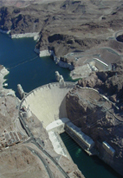
Colorado dammed
The Colorado River is interrupted by Hoover Dam just east of Las Vegas, and some of the flow is diverted for agricultural and municipal uses in the California desert.
Water Demand
Communities in the California desert rely on non-local surface water sources, such as Northern California and the Colorado River, for much of their water. Many regional sources are depleted or nearly depleted.1 A lack of surface water has led to heavy reliance on groundwater for agricultural and municipal uses, resulting in overdraft of groundwater basins. Low groundwater levels place land at greater risk for subsidence.2 Subsidence, or a drop in land-surface elevations, can disrupt surface drainage, reduce aquifer-system storage capacity, form earth fissures, and damage wells, buildings, roads, and utility infrastructure.3
1 R.H. Webb, L.F. Fenstermaker, J.S. Heaton, D.L. Hughson, E.V. McDonald, and D.M. Miller, “The Mojave Desert: Ecosystem Processes and Sustainability Revisited,” in The Mojave Desert: Ecosystem Processes and Sustainability, ed. R.H. Webb, L.F. Fenstermaker, J.S. Heaton, D.L. Hughson, E.V. McDonald, and D.M. Miller, (Reno: The University of Nevada Press, 2009) 457-464.
2 M. Sneed., M.E. Ikehara, S.V. Stork, F. Amelung, D.L. Galloway, “Detection and measurement of land subsidence using interferometric synthetic aperature radar and global positioning system, San Bernardino County, Mojave Desert, California: Water-Resources Investigations Report No. 03-4015,” (Sacramento: U.S. Department of the Interior, US Geological Survey, 2003), http://pubs.usgs.gov/wri/wri034015/.
3 M. Sneed., M.E. Ikehara, S.V. Stork, F. Amelung, D.L. Galloway, “Detection and measurement of land subsidence using interferometric synthetic aperature radar and global positioning system, San Bernardino County, Mojave Desert, California: Water-Resources Investigations Report No. 03-4015,” (Sacramento: U.S. Department of the Interior, US Geological Survey, 2003), http://pubs.usgs.gov/wri/wri034015/.
